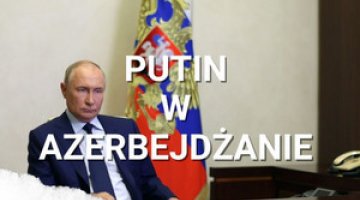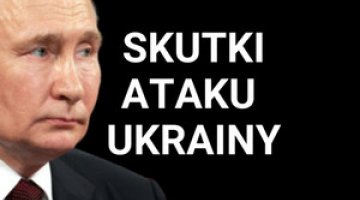Russians begin withdrawal from Kherson. 259th day of the war

On 9 November, during a meeting between Russian Defence Minister Sergey Shoigu and ‘special operation’ commander General Sergey Surovikin, it was reported that Russian forces operating in the Kherson area would be withdrawn to the left bank of the Dnieper and take up a defensive position along the river. The Russian commander assessed that the destruction of the Nova Kakhovka dam and the intensive discharge of water through the Kyiv power plant dam could result in the ‘complete isolation’ of a group of troops on the right bank of the Dnieper. He stressed that the aim was thus to save the lives of the troops and preserve their combat capability so they could be engaged in other directions. According to Surovikin’s announcement, a ‘manoeuvre of troops’ by Russian troops will be carried out shortly. He assured that engineering units were maintaining the Dnieper River crossings despite their destruction by Ukrainian rocket artillery and that more than 115,000 people had been evacuated from the right bank of the Dnieper.
Surovikin’s statement was met with a reserved response from Kyiv. Referring to the news of the aggressor’s planned withdrawal, President Volodymyr Zelensky said it was not so much a gesture of goodwill as the result of the Ukrainian army’s efficient actions. He warned the Kremlin that an attempt to blow up the Nova Kakhovka hydroelectric plant and deprive the Zaporizhzhia nuclear plant of cooling would amount to ‘declaring war on the whole world’. On 10 November, Deputy Chief of the General Staff’s Main Operational Directorate Oleksiy Hromov stated that the withdrawal of Russian forces from Kherson resulted from active operations by Ukrainian troops, which had destroyed the enemy’s logistical routes and supply system and breached its command system. Adviser to the head of the President’s Office Mykhailo Podolyak pointed out that, so far, there is no sign of the aggressor’s troops leaving Kherson, which remains on the right bank of the Dnieper.
As late as 8 November, the Russians were still to reinforce the grouping on the right bank of the Dnieper, including by redeploying tanks there using ferry crossings. At the same time, the evacuation of civilians to the left bank was to continue, including using the damaged Antonov Bridge. There were also further Ukrainian attacks that day in the Posad-Pokrovske village area on the border between Mykolaiv and Kherson oblasts, near Snihurivka in Mykolaiv Oblast, where fighting was particularly heavy, and between Davydiv Brid and Dudchany in Kherson Oblast. On 9 November, Russian sappers were to start blowing up bridges on the main road along the right bank of the Dnieper and from the north towards Kherson. The invading subunits also abandoned some positions on the line of contact. In the evening, Ukrainian reconnaissance subunits were to enter Pravdyne south-west of the village of Posad-Pokrovske and Kalynivske south-west of Davydiv Brid, and Snihurivka in the morning of 10 November.
Russian forces are continuing offensive operations in Donetsk Oblast. They have been unsuccessfully attacking Ukrainian positions on the outskirts of Bakhmut, in towns to the northeast and south of it, and north of Horlivka. Fighting continues in an arc west of Donetsk and north and south of Vuhledar. In the Pavlivka area, Ukrainian forces were expected to counterattack, and the Russians suffered particularly heavy losses. Attacks from both sides occurred in the Luhansk Oblast, in the direction of Svatove.
The start of the withdrawal from the right bank of the Dnieper River did not affect the activity of the invaders’ artillery and aviation, which continued to shell and bombard Ukrainian army positions and facilities along the entire line of contact and in the Chernihiv and Sumy border areas. The Russians also continued rocket and drone attacks on energy and industrial infrastructure in Dnipro, Kryvyi Rih, Kramatorsk and Mykolaiv, and the Kremenchuk and Zaporizhzhia region. Ukrainian artillery and aviation attacked mainly in the Kherson Oblast and, to a lesser extent, in Donbas. The Ukrainian diversion allegedly occurred in the Mariupol area.
The Pentagon confirmed the transfer to Ukraine of the first two NASAMS air defence systems, which were already used in combat operations. Aspide anti-aircraft missile launchers were also due to arrive in Ukraine from Spain. Ukraine was also due to receive the first six Spartan combat reconnaissance vehicles out of 14 purchased in the UK by Petro Poroshenko’s foundation. In addition, the British Ministry of Defence announced the transfer of nearly 1,000 additional missiles for anti-aircraft launchers. The French Ministry of Defence announced the first six CAESAR gun-howitzers from the new batch, which are expected to arrive in Ukraine in a few weeks.
On 9 November, the Chief of the US Joint Chiefs of Staff, Gen Mark Milley, called the Russian invasion of Ukraine ‘a huge strategic mistake’. He did not rule out that the losses suffered by Russia (more than 100,000 dead and wounded) and Ukraine would lead to the possibility of negotiations to end the conflict being considered if the front line stabilised. He added that the US would continue to arm Ukraine even if a complete military victory for either side seems increasingly unlikely. He confirmed that US military officials are seeing initial signs that Russia is withdrawing from Kherson. He added that it could take weeks to withdraw 20,000–30,000 troops from the west bank of the Dnieper. In contrast, British intelligence estimates that the withdrawal of the invading forces from the right-bank part of the Kherson Oblast will take place within days under cover of artillery fire. The aggressor’s ability to hold forces on the west bank of the Dnieper has been compromised by Ukrainian attacks on Russian supply routes.
On 7 November, President Zelensky announced the transfer of assets of strategically essential enterprises to the state. He justified this by the need to support the armed forces. The National Securities Commission of Ukraine published a resolution on the compulsory state seizure of the shares of Ukrnafta, Ukrtatnafta, Motor Sich, AvtoKrAZ and Zaporozhtransformator. The seized assets were given the status of military property, and their management was handed over to the Ministry of Defence. The authorities do not rule out that once the war is over, the companies will be returned to their owners or compensation will be paid. Ukrnafta is the country’s largest gas and oil production company and has the most developed network of petrol stations. Ukrtatnafta, on the other hand, is an oil refining company. Oligarch Ihor Kolomoyskyi held shares in them. The automotive company AvtoKrAZ is part of the Finance and Credit group of Kostyantyn Zhevago, who left Ukraine and moved to Monaco, while the transformer manufacturer Zaporozhtransformator belonged to Kostyantyn Hryhoryshyn. The Motor Sich aerospace plant takeover is symbolic – it became state property as recently as spring 2021, and its former owner Vyacheslav Bohuslayev is in custody over allegations of collaboration with the Russians. The authorities have stressed that this is not a nationalisation of the companies but only a temporary takeover under martial law. The head of the defence ministry pointed out that their production plays a vital role in maintaining the potential of the Armed Forces, including the supply of fuels and lubricants and the repair of damaged equipment, and the takeover of transformer plants is necessary to carry out repairs to energy infrastructure destroyed by the enemy.
On 9 November, the Security Service of Ukraine reported neutralising an FSB sabotage group operating in Kyiv and Sumy Oblast. The enemy’s primary tasks included collecting personal data and locating commanders of Ukrainian units. The information received was planned to prepare for the physical elimination of military officers and the destruction of weapons stores and military equipment.
On the same day, the head of the SBU Cyber Security Department, Illya Vityuk, conveyed that cyberattacks accompanied the shelling of energy facilities. The Russians are carrying out more than 10 of them daily, which in the worst cases, can cause power cuts. According to Vityuk, most cyberattacks are carried out by Russian special services supported by Belarusian services. The number of attacks has been increasing in recent years: in 2020 there were around 800, in 2021 – almost 1,400, and this year – more than 3,500.
Commentary
- General Surovikin had already signaled the possibility of invaders leaving the Kherson region. On 18 October, he acknowledged that ‘a difficult situation had arisen there’, and considered it expedient for the occupation authorities to evacuate the civilian population. He points out that the decision was announced by senior military officers, thus maintaining the appearance of a planned military operation with no political consequences, especially as the Russians had built three fortified defence lines on the left bank of the Dnieper. Publicising the decision on a ‘planned manoeuvre’ is also intended to reassure its public, concerned about the rising costs of the war. To this end, the military stresses that the primary task is to protect soldiers’ lives.
- Politically, the withdrawal from Kherson will be a political defeat for the Kremlin and a discredit to the 30 September annexation of occupied Ukrainian territory. It will undermine the state’s authority, which proves to be incapable of guaranteeing the security of part of its ‘own’ territory and lead to a decline in the confidence of those collaborating with the Russians. In an attempt to lower the political cost of the decision, Kremlin propaganda presents it as part of a well-thought-out military operation to ensure the success of the offensive in another direction.
- In military terms, the decision to withdraw should be judged as adequate to the situation. The invaders could not provide adequate cover for the Dnieper River crossings against the defenders’ artillery fire (mainly from HIMARS launchers) and, thus – timely supply deliveries to the fighting units. Although the Ukrainian offensive has not made significant progress in the Kherson Oblast since the beginning of October, and the Russians have repulsed repeated attacks, keeping troops in the area in question has only generated costs for the aggressor.
- The decision does not guarantee that the Russians will quickly leave the right bank of the Dnieper. Everything depends on the actions taken by the Ukrainian side, for which enemy troops crossing the river will be a convenient target. The aggressor will most likely defend against such a risk by evacuating soldiers together with the oblast’s inhabitants (using them as human shields). Moves to slow down their movement (destroying crossings, mines on the ground and civilian facilities) also safeguard against the rapid advance of enemy forces. If these prove ineffective, it cannot be ruled out that the Russians will halt their withdrawal and put up determined resistance to avoid a massacre of evacuated soldiers.
- The relocation of the line of contact in the Kherson Oblast to the Dnieper means that the conduct (continuation) of offensive operations by either side will involve forcing the river. Currently, however, neither Ukrainian nor Russian forces can carry out a major landing operation. In the case of Ukraine, its possible implementation depends entirely on the will of the West, which would have to provide all the necessary resources. Therefore, it must be assumed that the Dnieper line could become the border of Russian-occupied territory for an extended period.
Map. Military situation in southern Ukraine (as of 10 November 2022)






